We had picked one of the hottest days of the summer to meet, and it was already stifling by the time we met at the reception at just after 10am.
After being introduced to each other and introducing family etc, we both headed straight off to the Scrape in pursue of Garganey, which had been reported. It was a lifer for both of us, and I'd dipped it twice already. While en route to the Scrape hide, we saw numerous species like Green Woodpecker, Reed Warbler, Blackcap etc and a nice Emperor Dragonfly or 10.
From the Scrape hide, there was no sign of Garganey though there were at least 50+ Sand Martin at their nesting bank, largely due to the successful breeding with most of them juveniles.
We went to the Peacock Tower, but there was very little from there, though a WWT staff member found a Common Sand. A possible juv YLG flew by, but all else was quiet. Then while I scanned a bank on the far side a dark shape blocked my view. Kabir said he saw a green speculum, with white flanks pointing towards Garganey. I didn't see it too well at all, and didn't tick a sighting like that. Another successful dip.
After thanking the guide Dave, we started to trudge back to the visitor centre, getting stopped by Six-spot Burnets, Blue butterflies, Chiffchaff, Reed Warbler, gulls and really anything that moved.
After thanking the guide Dave, we started to trudge back to the visitor centre, getting stopped by Six-spot Burnets, Blue butterflies, Chiffchaff, Reed Warbler, gulls and really anything that moved.
Once we'd finished lunch, we used the Wildside route to get closer views of some of the butterflies and Common terns - 6 of which were seen, including a very snoozy bird on the Reservoir Lagoon. An ad Snipe dropped down onto the marsh while we were there, and a m Reed Bunting showed briefly.
Soon after we'd completed the wildside route Kabir (https://twitter.com/Kaulofthewilduk) and his twin Aryan (https://twitter.com/AryanKaul6) and mum left the reserve; it was great to meet them, and pleasing to know that there were numerous young birders in London.
Whilst strolling around the wildside area, waiting for my mum and sister to return, I had a quick search for Small Copper unsuccessfully, though some great views of Common Blue butterfly and Brown Argus, with the addition of numerous dragonfly species.
It was an enjoyable day birding and watching the wildlife, despite the intense heat, limited bird quality and limited time because of it.
 |
| Common Sand digiscope |
 |
| Sand Martin |
 |
| Little Grebe |
 |
Common Tern
|
 |
| Grey Heron and BHG |
 |
| the snoozy Common Tern |
 |
| Forwards |
 |
| Backwards |
 |
| Right |
 |
| Left |
Video




















